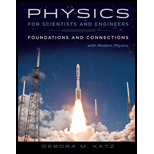
Concept explainers
(a)
The average speed of the 12 atoms in the cylinder.
(a)
Answer to Problem 10PQ
The average speed of the 12 atoms in the cylinder is
Explanation of Solution
Write the expression for average speed.
Here,
Conclusion:
Substitute
Therefore, the average speed of the 12 atoms in the cylinder is
(b)
The rms speed of the 12 atoms in the cylinder.
(b)
Answer to Problem 10PQ
The rms speed of the 12 atoms in the cylinder is
Explanation of Solution
Write the expression for rms speed.
Here,
Conclusion:
Substitute
Therefore, the rms speed of the 12 atoms in the cylinder is
Want to see more full solutions like this?
Chapter 20 Solutions
Webassign Printed Access Card For Katz's Physics For Scientists And Engineers: Foundations And Connections, 1st Edition, Single-term
- Not sure what I'm doing wrong. I know that Fc= (m)(v^2/r) with: m= 0.0011kg r=0.84/2 Fc=3.9N but when I plug all that into the equation, I'm being told it's wrong. What am I missing?arrow_forwardThe mass of a star similar to the Sun is 2.04 ✕ 1030 kg, and the mass of an atom of hydrogen, of which the Sun is mostly composed, is 1.67 ✕ 10-27 kg. How many atoms are in the star?arrow_forwardmgh = 1 mv ₁ ² 2 Duph FAST 2 m = 1.00 kg 9 = 9.80 m/s² V₁ = 11 m/s ² 2 08.P Solve for hieght (h) MUN TIEarrow_forward
- A neutron star is composed of neutrons and has a density that is approximately the same as that of a nucleus (about 2.3 × 1017 kg/m3). What is the radius of a neutron star whose mass is 1.20 times the mass of the sun (M = 1.99 × 1030 kg)?arrow_forwardYou are on an interstellar mission from the Earth to the 8.7 light-years distant star Sirius. Your spaceship can travel with 70% the speed of light and has a cylindrical shape with a diameter of 6 m at the front surface and a length of 25 m. You have to cross the interstellar medium with an hydrogen atom/m a) calculate the time it takes your spaceship to reach Sirius. b) Determine the mass of interstellar gas that collides with your spaceship during the mission. Note: Use 1.673 x 10-27 kg as proton mass.arrow_forward4xgxcoseyxD T×D4×AP128xµ×L h= 0,53 cm Q= 72000 cm³/s D= 20 mm D= 2mm 0= 45° y= 13600N/m3 0= .. .N/m u= 400 kN s/km2 L= 1000 cm AP=. .N/m2 (Pa) 2xgxhxycy-1 V×D9 h= 76 mm Re= 121538 (boyutsuz) Yc= 0,0136 N/cm3 V= 12,01 km/h 9- 46,8 cm?/s V= 7,9.10-' m/s D=.... .m g= 9,81 m/s? Y=.. .kN/m³ 8×LxQ2xfr2×g×D5 L= 5 km f= 0,01277 (boyutsuz) g= 9,81 m/s? Q= 1440000 dm³/h D= 442,1 mm h=........marrow_forward
- Question 1 Make the conversion of 2.4 Km/h2 to m/s2. O 6.67 E(-4) 1.85 E(-4) 1.85 E(-7) 0.67 1.5 Question 2 In solving a physics problem you end up with m in the numerator and m/s in the denom units for your answer are O m/s O m^2/s O m O 1/s Question 3arrow_forwardOne molecule of water (H2O) contains two atoms of hydrogen and one atom of oxygen. A hydrogen atom has a mass of 1.0 u and an atom of oxygen has a mass of 16 u, approximately. (a) What is the mass of one molecule of water? (b) How many molecules of water are in the world's oceans, which have an estimated total mass of 1.4 × 1021 kg?arrow_forwardConsider Use them k=9.00×10^9 N.m^2/C^2 ε0= 8.85×10^-12 C^2/N.m^2 µ0=4π×10^-7 T.m/A mp=1.67×10^-27 kg me=9.11×10^-31 kg e=1.6×10^-19 C g=10.0 m/s^2 Do not approximate at all ???arrow_forward
- (a) Taking A = (6.00 î – 8.00 j) units, B = (-8,00 Î + 3.00 j) units, and C = (26.0 î + 19.0 ĵ) units, determine a and b such that a à + b B + T = 0. (b) A student has learned that a single equation cannot be Figure P22 solved to determine values for more than one unknown in it. How would you explain to him that both a and b can be determined from the single equation used in part (a)?arrow_forwardCalculate the speed (in m/s) of an electron and a proton with a kinetic energy of 1.15 electron volt (eV). (The electron and proton masses are me = 9.11 ✕ 10−31 kg and mp = 1.67 ✕ 10−27 kg. Boltzmann's constant is kB = 1.38 ✕ 10−23 J/K.) (a) an electron m/s (b) a proton m/s (c) Calculate the average translational kinetic energy in eV of a 3.09 ✕ 102 K ideal gas particle. (Recall from Topic 10 that 1 2 mv2 = 3 2 kBT.) eVarrow_forwardThe density of aluminum is 2.7 g/cm^3. How much mass is contained in a chunk of aluminum with a volume of 379mL?arrow_forward
 College PhysicsPhysicsISBN:9781938168000Author:Paul Peter Urone, Roger HinrichsPublisher:OpenStax College
College PhysicsPhysicsISBN:9781938168000Author:Paul Peter Urone, Roger HinrichsPublisher:OpenStax College
